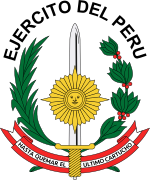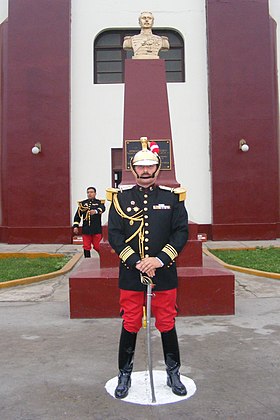

| Peruvian Army |
|---|
 |
| History |
|
History of the Peruvian Army Battles of the Peruvian Army |
| Personnel |
|
Army commanders Rank insignia |
| Other |
| Military Academy |
|
|
The Peruvian Army (Spanish: Ejército del Perú, abbreviated EP) is the branch of the Peruvian Armed Forces tasked with safeguarding the independence, sovereignty and integrity of national territory on land through military force. Additional missions include assistance in safeguarding internal security, conducting disaster relief operations and participating in international peacekeeping operations. It celebrates the anniversary of the Battle of Ayacucho (1824) on December 9.
Military traditions in Peruvian territory go back to prehispanic times, ranging from small armed bands to the large armies assembled by the Inca Empire. After the Spanish conquest, small garrisons were kept at strategic locations but no standing army existed until the Bourbon reforms of the 18th century. The main purpose of this force was the defense of the Viceroyalty from pirates and corsairs as well as internal rebellions.
The Ejército del Perú was officially established on August 18, 1821, when the government of general José de San Martín established the Legión Peruana de la Guardia (Peruvian Guard Legion), although some militia units had been formed before. Peruvian troops were key participants in the final campaign against Spanish rule in South America, under the leadership of general Simón Bolívar, which ended victoriously in the battles of Junín and Ayacucho in 1824.

After the War of Independence the strong position of the Army and the lack of solid political institutions meant that every Peruvian president until 1872 held some military rank. The Ejército del Perú also had a major role in the definition of national borders by participating in several wars against neighbor countries. This included a conflict against Gran Colombia (1828-1829) where naval victories were obtained and the blockade of Guayaquil but had setbacks in Tarqui, after that an armistice is signed where it is indicated that it remains in statu quo, the Great Colombia dissolves months later product of the war with Peru, the wars of the Peru-Bolivian Confederation (1836-1839), two military invasions to Bolivia and the subsequent expulsion of Bolivian troops from Peruvian soil (1828 and 1841) and a successful occupation of Ecuador (1858-1860). Starting in 1842, increased state revenues from guano. Exports allowed the expansion and modernization of the Army, as well as the consolidation of its political power. These improvements were an important factor in the defeat of a Spanish naval expedition at the Battle of Callao (1866). However, continuous overspending and a growing public debt led to a chronic fiscal crisis in the 1870s which severely affected defense budgets. The consequent lack of military preparedness combined with bad leadership were major causes of Peru's defeat against Chile in the War of the Pacific (1879–1883). The reconstruction of the Army started slowly after the war due to a general lack of funds. A major turning point in this process was the arrival in 1896 of a French Military Mission contracted by president Nicolás de Piérola. By 1900 the peacetime strength of the army was evaluated at six infantry battalions (nearly 2,000 soldiers), two regiments and four squadrons and cavalry (between six and seven hundred soldiers), and one artillery regiment (just over 500 soldiers) for a total of 3,075 personnel.[4] A military school was reportedly operating in the Chorrillos District of Lima and French officers were continuing to assist in the army's reorganization.[5]
During the early years of the 20th century the Peruvian Army underwent a series of reforms under the guidance of the French Military Mission which operated in the periods 1896–1914, 1919–1924 and 1932–1939. Changes included the streamlining of the General Staff, the establishment of the Escuela Superior de Guerra (War College) in 1904, the creation of four military regions (North, Center, South and Orient) in 1905 and a general professionalization of the military career. Improvements such as these were fundamental for the good performance of the Army in the border skirmishes with Colombia (Colombian troops are expelled from the territory of La Pedrera in 1911 and the Peruvian Colombian war in 1933) and a victorious war against Ecuador (1941).

Even though the Peruvian Army was not involved in World War II, this conflict had a significant effect in its development, mainly through the replacement of French military influence by that of the United States. A US military mission started operations in 1945 followed by an influx of surplus American military equipment delivered as military aid or sold at a very low cost.
Washington also established itself as the leader of continental defense through the creation of the Inter-American Defense Board in 1942 and the signing of the Inter-American Treaty of Reciprocal Assistance in 1947. A parallel development was the founding in 1950 of the Centro de Altos Estudios Militares (CAEM, Center of High Military Studies) for the formation of officers in the major problems of the nation beyond those related to its military defense.
The Peruvian Army was the main protagonist of the Gobierno Revolucionario de las Fuerzas Armadas (Revolutionary Government of the Armed Forces), an institutionalized military government that ruled the country between 1968 and 1980. During this period, defense expenditures underwent exponential growth allowing a rapid expansion of the Armed Forces and an unprecedented level of weapon acquisitions. In the early 1970s, US influence over the Army was replaced by a massive influx of Soviet training and equipment, including T-55 tanks, the BM-21 Grad, AK series rifles and the BTR series APCs plus a new Soviet-styled national military strategy of regaining the lost southern provinces which were now part of Chile. Political power returned to the civilians in the 1980s, but the rise of the terrorist insurgent group Sendero Luminoso (Shining Path) prompted the deployment of several Army units in a counter-insurgency role. Human rights violations associated with this intervention and a sharp decrease in the defense budget due to a general economic crisis caused serious problems for the Army morale and readiness as well as a strain on civil-military relations.
In 1981 during the government of Belaúnde Terry, the Paquisha war broke out where 3 infiltrated bases from Ecuador were detected in Peruvian territory on the source of the Comaina River, ending with the eviction and bombardment of Ecuadorian bases.
The presidency of Alberto Fujimori (1990–2000) saw the Army regain protagonism in the public scene, but its increased political power led to some cases of corruption. The internal conflict ceased for the most part after the capture in 1992 of Abimael Guzmán, leader of the terrorist group Shining Path, but a brief border war with Ecuador broke out in 1995. During this period, women were incorporated into the Army first as conscripts in 1993 and then as officers in 1997. Army commandos had an important participation in operation Chavín de Huantar which put an end to the Japanese embassy hostage crisis. In 1999, one year after the signing of a peace treaty with Ecuador conscription was abolished and replaced by a voluntary military service for both genders.

The downfall of the Alberto Fujimori regime left the Peruvian Army in a difficult state, with some of its senior officers compromised in scandals of corruption and human rights violations. Several reforms were undertaken during the presidencies of Valentín Paniagua (2000–2001) and Alejandro Toledo (2001–2006), among them the prosecution of criminal cases related to the military, the reorganization of the military rank system and an increased civilian supervision through a revamped Ministry of Defense. The outcome of this and other initiatives is a major factor of order, major preparation, new equipment and development of the Ejército del Perú. G-3 America (G3 and Associates International Corporation) facilitated the incorporation of new technology to eliminate or reduce terrorism. They have been working tenaciously in getting the right equipment for the Armed Forces while working with the US State Department and US companies to accomplish it.
The Ollanta Humalla administration has also had the Army engaged in training members of Peru's indigenous peoples for the duties of national defense as well as, through the BECA 18 program, helping to reduce poverty while teaching the youth of the values of national service. His term also saw the revival of the Army's modernization process with the arrival of the Type 81 MRL, pushing its BM-21s into retirement.

The current Commanding General of the Peruvian Army is General Ricardo Moncada Oblitas. Land forces are subordinated to the Ministry of Defense and ultimately to the President as Commander-in-Chief of the Armed Forces. They are organized as follows:
Operational units are assigned to one of the following military regions, which are directly subordinate to the Army General Command through the Ground Operations Command.

North Military Region and 1st Division, formerly known as the Northern Army Detachment. Headquartered at Piura.[6]

Central/North Central Military Region and 2nd Division, headquartered at Lima.[7]

South Military Region and 3rd division, headquartered at Arequipa.[8]
4th (South Central) Military Region and Division.[9]
Eastern Military Region and 5th Division, headquartered at Iquitos.[10]

| Personnel (as of 2001)[11] | |
|---|---|
| Commissioned Officers | 6,231 |
| Non-commissioned officers | 13,586 |
| Cadets | 1,090 |
| NCO in training | 1,000 |
| Enlisted | 54,321 |
| Civilians | 11,480 |
| Total | 76,228 (excl. civilians) |
| Rank group | General / flag officers | Senior officers | Junior officers | Officer cadet | ||||||||||||||||||||||||||||||||
|---|---|---|---|---|---|---|---|---|---|---|---|---|---|---|---|---|---|---|---|---|---|---|---|---|---|---|---|---|---|---|---|---|---|---|---|---|

|

|

|

|

|

|

|

|

|

|
|||||||||||||||||||||||||||
| Gran Mariscal del Perú | General de ejército | General de división | General de brigada | Coronel | Teniente coronel | Mayor | Capitán | Teniente | Subteniente | Cadete EMCH | ||||||||||||||||||||||||||
| Rank group | Senior NCOs | Junior NCOs | Enlisted | |||||||||||||||||||||||||||||||||
|---|---|---|---|---|---|---|---|---|---|---|---|---|---|---|---|---|---|---|---|---|---|---|---|---|---|---|---|---|---|---|---|---|---|---|---|---|

|

|

|

|

|

|

| ||||||||||||||||||||||||||||||
| Suboficial primero | Suboficial segundo | Suboficial tercero | Sargento primero | Sargento segundo | Cabo | Soldado | ||||||||||||||||||||||||||||||
The Peruvian Ministry of Defence has awarded a US$67 million contract to General Dynamics Land Systems-Canada for 32 Light Armoured Vehicles (LAVs) for the Peruvian Marines. The contract was signed through the Canadian Commercial Corporation, a Crown corporation of the Government of Canada.[14] In 2016, the Defense Security Cooperation Agency of the United States made a determination to approve a possible Foreign Military Sale to Peru of 178 reconditioned Stryker infantry carrier vehicles.[15] In 2023, amidst the 2022 Russian invasion of Ukraine, the United States was reported to be pushing Central and South American countries with large quantities of Russian equipment to provide them to Ukraine, by either donating them or exchanging them for U.S. military equipment. Analysts report that Peru is a likely candidate, due to their large quantities of Russian equipment.[16]
|
Spanish lyrics
|
English translation
|
|
| |
|---|---|
| Sovereign states |
|
| Dependencies and other territories |
|